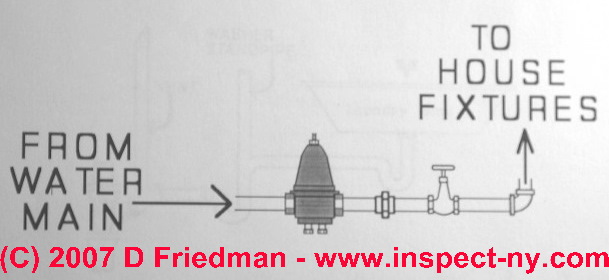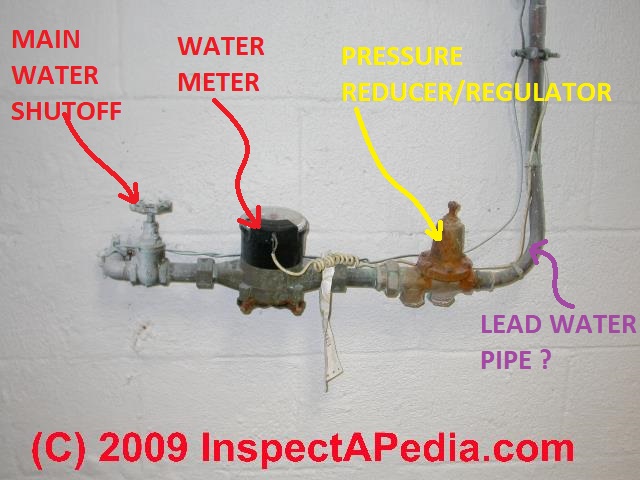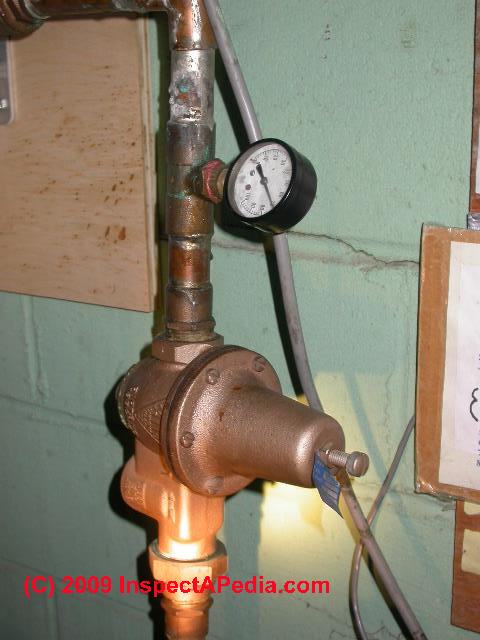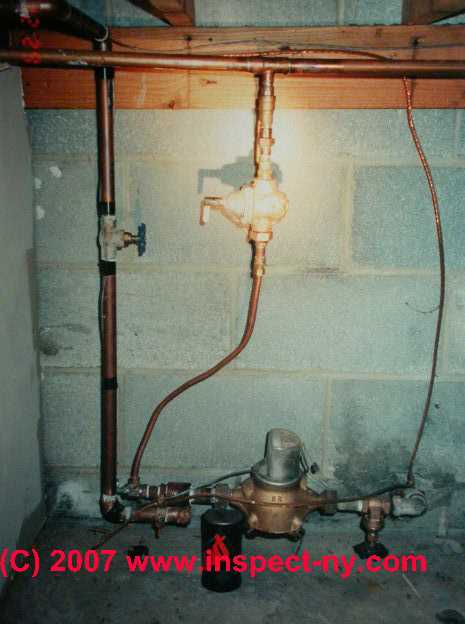 Water Pressure Regulator & Pressure Reducing Valve
Water Pressure Regulator & Pressure Reducing Valve
Problem Diagnosis & Regulator Adjustment or Repair
- POST a QUESTION or COMMENT about troubleshooting water pressure regulators
Bad water pressure regulator:
How to diagnose and fix or replace a bad water pressure regulator.
This article describes Diagnosing a Bad Water Pressure Regulator - how to diagnose the loss of water pressure and the need for a replacement water pressure regulator. The process of water pressure problem diagnosis and the costs of the repair are explained.
InspectAPedia tolerates no conflicts of interest. We have no relationship with advertisers, products, or services discussed at this website.
- Daniel Friedman, Publisher/Editor/Author - See WHO ARE WE?
Water Pressure Regulator / Pressure Reducing Valve Failures
 Water pressure regulators are devices that protect building plumbing systems from excessive water pressure damage by reducing incoming high water main pressure (that can be more than 150 psi in some communities) to a safe level (typically 50 psi) in the building.
Water pressure regulators are devices that protect building plumbing systems from excessive water pressure damage by reducing incoming high water main pressure (that can be more than 150 psi in some communities) to a safe level (typically 50 psi) in the building.
[Click to enlarge any image]
Our photo (left) shows typical incoming municipal water piping at a building.
From left to right we see a main water shut off valve, a water meter (wires lead to an outdoor water meter reading device), a water pressure regulator, and water piping rising into the building.
The three articles listed just below discuss how to adjust a water pressure regulator:
- WATER PRESSURE REDUCER / REGULATOR
- WATER PRESSURE VARIATION CAUSES
- WATER PRESSURE REGULATOR ADJUSTMENT
Expansion tanks to relieve high water pressure:
An alternative to installing or changing a water pressure regulator when building water pressure is occasionally 80 psi or higher is the installation of an expansion tank to temporarily absorb that pressure increase.
Proper use of an expansion tank can help avoid unnecessary opening of the pressure/temperature relief valve on a hot water heating tank or a hot water heating boiler.
The water pressure regulator can be adjusted to improve building water pressure and thus flow, by loosening a lock nut on the regulator and screwing the adjustment screw up or down a few turns.
 Our photo shows the water pressure regulator (photo bottom) and the regulator screw and lock-nut.
Our photo shows the water pressure regulator (photo bottom) and the regulator screw and lock-nut.
Be careful not to set the building water pressure too high, as you'll cause leaks.
For details on adjusting a municipal water pressure regulator
see WATER PRESSURE REGULATOR ADJUSTMENT
Watch out: don't set the water pressure reducing valve higher than necessary. Doing so wastes water and as we discuss
at WATER PRESSURE TOO HIGH: DANGERS, setting water pressure too high can cause both plumbing problems and actual serious safety hazards at buildings.
Causes of Variation in Building Water Pressure
As we discuss in more detail at WATER PRESSURE VARIATION CAUSES, there are several causes of variation in building water pressure:
- Number of plumbing fixtures being run at once
- Variation in municipal water delivery pressure
- Variation in small community water systems and private well pump water delivery pressure Details are
at PUMP PRESSURE CONTROL ADJUSTMENT. - Water pipe diameter, length, elbows and bends:
See DEFINITION OF STATIC WATER PRESSURE
and DEFINITION OF DYNAMIC WATER PRESSURE - Clogged water pipes reduce water flow rate, not water pressure.
- Variations in building occupancy levels
How do we Diagnose Poor Municipal Water Pressure & Flow in a Building - 5 Key Checks
Key things to check when water pressure and flow are inadequate in a building served by municipal water supply are
- The condition of individual plumbing fixtures, faucets, valves, and controls.
A clogged sink or shower strainer will cause bad water pressure at individual fixtures while others may flow freely. A plumbing shutoff valve that is partly closed or clogged with debris will cause bad water flow at that fixture. - The incoming municipal supply pressure.
The municipal water supply source may be delivering water at low pressure. - The condition of water piping between the building and the street water main.
An older water supply pipe connecting the building to the water main in the street may be small in diameter, clogged with minerals, rust, or debris, or it could be leaking underground. - The condition of building water supply piping. Clogged pipes due to minerals or rust, small diameter piping, long piping
For details about the above items,
see MUNICIPAL WATER PRESSURE DIAGNOSIS - The setting of the water pressure regulator at the building water meter or water shutoff valve. This topic is discussed just below.
 Bad water pressure regulator or bad pressure regulator adjustment: (poor municipal water pressure)
Bad water pressure regulator or bad pressure regulator adjustment: (poor municipal water pressure)
if the building is connected to a municipal water supply there may be a water pressure regulator installed, usually close to the water meter or where the water supply pipe enters the building. Photos of water pressure regulators and diagnosis and adjustment advice are
at WATER PRESSURE REDUCER / REGULATOR.
If the water pressure control was set too low to start with
or if there is a problem with the water pressure regulator, you may see an improvement in water pressure by diagnosing and adjusting or repairing this control.
If the loss of water pressure was sudden,
it's not likely to be a problem the pressure regulator except in the less common cases of a blockage or failure in the regulator itself.
In this photo our flashlight lights up a (rather amateurish looking) water pressure regulator installed on a municipal water supply.
You can see that a previous connection to the water meter was cut, left shut off (see that shutoff valve at the left hand vertical pipe - what happens if someone opens that valve?), and new fittings were installed to conduct incoming water to the building water supply piping.
The use of smaller diameter flexible copper tubing might restrict the incoming water flow, but the presence of a pressure regulator at all suggests that the incoming pressure may have been excessive. (Too high water pressure leads to fixture leaks.)
How to Adjust the Water Pressure Regulator or Pressure Reducing Valve on Municipal Water Supply
Details about how to adjust the building water pressure regulator or pressure reducing valve are found
at WATER PRESSURE REGULATOR ADJUSTMENT. Excerpts are below.
We have already mentioned checking and adjusting the pressure control for the water pump on a private well system - just above. But what if the home does not have it's own well - what if the building is connected to a municipal water supply?
A water pressure regulator may be installed. See the illustration at the top of this article .
A device, usually a few inches across and often shaped a bit like a bell, may be found installed at the water meter. The water meter is often installed where water pipes enter the building and the pressure regulator will be installed just after the water meter on the same pipe. You may see a screw secured by a lock-nut on the top of the meter or there may be another screw or knob that will permit the water pressure regulator to be adjusted to set the water pressure up or down in the building.
Which way to turn the water pressure regulator screw?
On most pressure regulators, after loosening the lock-nut around the adjusting screw, turning the screw in will increase the water pressure. Don't overdo-it. Just a turn or two should make a difference. Keep track of the number of turns so that you can go back to where you started if necessary.
Sometimes the municipal water supply may itself be temporarily shut down
or running at reduced flow. Check with your local water department or neighbors.
Increasing the building water pressure by adjusting the pressure regulator
(or a pump pressure control switch) will not fix a poor water delivery rate from the source (municipal water main or local private water pump), but if the pressure was set too low to start with you may see an improvement by this adjustment. If your loss of water pressure or flow was sudden, it's not likely to be a problem with the pressure regulator except in the less common cases of a blockage or failure in the regulator itself.
Watch out: don't set the water pressure reducing valve higher than necessary. Doing so wastes water and as we discuss
at WATER PRESSURE TOO HIGH: DANGERS, setting water pressure too high can cause both plumbing problems and actual serious safety hazards at buildings.
A Guide to Building Water Pressure by Adjusting or Repairing the Water Pump Pressure Control Switch on a Private Pump and Well Water Supply
For details about diagnosing poor well water pressure and flow, start
at WELL WATER PRESSURE DIAGNOSIS or go directly to the individual items listed just below.
- How to Adjust Water Pump Pressure: The detailed, step by step procedure for inspecting and adjusting the water pressure control switch is
discussed in detail
at WATER PRESSURE CONTROL SWITCH ADJUSTMENTS. - Diagnosing Water Pump Short Cycling on and off: If your water pump is clicking on and off too often or quite rapidly
see SHORT CYCLING. - Diagnosing Water Pressure Drops without explanation when the pump stops,
see WATER PRESSURE FALLS SLOWLY, ERRATIC PUMP: bad pressure control switch, building water running or leak, bad pressure gauge, bad check valve, bad foot valve. - Diagnosing & Repairing Lost Air in the Water Tank: The problem of lost air in the water pressure tank along with how to correct that condition are discussed
beginning
at SIGNS OF AIR LOSS. - Diagnosing & Repairing a Water Pressure Control or Water Pump Control Switch: We discuss diagnosing and repairing a water pressure control switch that sticks "on" or "off" or simply won't operate,
at WATER PUMP PRESSURE SWITCH REPAIR
...
Continue reading at WATER PRESSURE REDUCER / REGULATOR or select a topic from the closely-related articles below, or see the complete ARTICLE INDEX.
Or see WATER PRESSURE REGULATOR FAILURE FAQs - questions & answers about bad pressure regulators posted originally on this page.
Or see these
Recommended Articles
- WATER PRESSURE REDUCER / REGULATOR
- WATER PRESSURE STOPS, RETURNS
- WATER PRESSURE TOO HIGH: DANGERS
- WATER PRESSURE TOO LOW
Suggested citation for this web page
WATER PRESSURE REGULATOR BAD at InspectApedia.com - online encyclopedia of building & environmental inspection, testing, diagnosis, repair, & problem prevention advice.
Or see this
INDEX to RELATED ARTICLES: ARTICLE INDEX to WATER SUPPLY, PUMPS TANKS WELLS
Or use the SEARCH BOX found below to Ask a Question or Search InspectApedia
Ask a Question or Search InspectApedia
Try the search box just below, or if you prefer, post a question or comment in the Comments box below and we will respond promptly.
Search the InspectApedia website
Note: appearance of your Comment below may be delayed: if your comment contains an image, photograph, web link, or text that looks to the software as if it might be a web link, your posting will appear after it has been approved by a moderator. Apologies for the delay.
Only one image can be added per comment but you can post as many comments, and therefore images, as you like.
You will not receive a notification when a response to your question has been posted.
Please bookmark this page to make it easy for you to check back for our response.
IF above you see "Comment Form is loading comments..." then COMMENT BOX - countable.ca / bawkbox.com IS NOT WORKING.
In any case you are welcome to send an email directly to us at InspectApedia.com at editor@inspectApedia.com
We'll reply to you directly. Please help us help you by noting, in your email, the URL of the InspectApedia page where you wanted to comment.
Citations & References
In addition to any citations in the article above, a full list is available on request.
- Watts, 815 Chestnut Street, North Andover, MA, USA 01845-6098, web search 09/18/2010 original source: http://www.watts.com/pages/learnAbout/reducingValves.asp?catId=64
Water Supply & Drain Piping, Wells, Pumps, Water Supply Equipment
- Access Water Energy, PO Box 2061, Moorabbin, VIC 3189, Australia, Tel: 1300 797 758, email: sales@accesswater.com.au Website: http://www.accesswater.com.au/
Moorabbin Office: Kingston Trade Centre, 100 Cochranes Rd, Moorabbin, VIC 3189
Australian supplier of: Greywater systems, Solar power to grid packages, Edwards solar systems, Vulcan compact solar systems, water & solar system pumps & controls, and a wide rage of above ground & under ground water storage tanks: concrete, steel, plastic, modular, and bladder storage tanks. - Grove Electric, Typical Shallow Well One Line Jet Pump Installation [PDF], Grove Electric, G&G Electric & Plumbing, 1900 NE 78th St., Suite 101, Vancouver WA 98665 www.grovelectric.com - web search -7/15/2010 original source: http://www.groverelectric.com/howto/38_Typical%20Jet%20Pump%20Installation.pdf
- Grove Electric, Typical Deep Well Two Line Jet Pump Installation [PDF], Grove Electric, G&G Electric & Plumbing, 1900 NE 78th St., Suite 101, Vancouver WA 98665 www.grovelectric.com - web search -7/15/2010 original source: http://www.groverelectric.com/howto/38_Typical%20Jet%20Pump%20Installation.pdf
- Our recommended books about building & mechanical systems design, inspection, problem diagnosis, and repair, and about indoor environment and IAQ testing, diagnosis, and cleanup are at the InspectAPedia Bookstore. Also see our Book Reviews - InspectAPedia.
- In addition to citations & references found in this article, see the research citations given at the end of the related articles found at our suggested
CONTINUE READING or RECOMMENDED ARTICLES.
- Carson, Dunlop & Associates Ltd., 120 Carlton Street Suite 407, Toronto ON M5A 4K2. Tel: (416) 964-9415 1-800-268-7070 Email: info@carsondunlop.com. Alan Carson is a past president of ASHI, the American Society of Home Inspectors.
Thanks to Alan Carson and Bob Dunlop, for permission for InspectAPedia to use text excerpts from The HOME REFERENCE BOOK - the Encyclopedia of Homes and to use illustrations from The ILLUSTRATED HOME .
Carson Dunlop Associates provides extensive home inspection education and report writing material. In gratitude we provide links to tsome Carson Dunlop Associates products and services.

